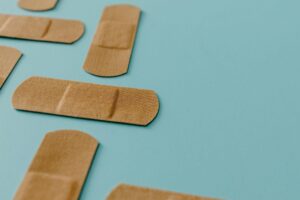When a wound is not properly cared for, it can become infected. Infections in wounds are a common occurrence, but they can lead to serious complications if not treated properly. Recognizing the early signs of infection can help avoid further health risks and speed up recovery.
In this blog, you will learn how to spot these signs and what steps to take next, from infected wound treatment at home to seeking professional care.
Common Signs of an Infected Wound

Wound infections occur when harmful bacteria enter the body through a break in the skin. The immune system works to fight off the bacteria, but when the body is unable to keep up, infection sets in. The following are some of the most common signs of an infected wound.
1. Increased Redness Around the Wound
One of the first signs that a wound may be infected is increased redness around the area. If the redness expands beyond the immediate vicinity of the wound, it may indicate an infection. This occurs because the body is sending blood to the area to fight off the infection. However, if the redness doesn’t subside over time, it’s a sign that the infection is worsening.
2. Swelling and Warmth
A swollen wound that feels warm to the touch is another red flag. Swelling occurs as the body’s immune system works to contain the infection, while warmth is a natural response to the infection itself. If these symptoms persist or become more severe, immediate action should be taken to prevent the infection from spreading.
3. Pain or Tenderness

Pain and tenderness around a wound are common, especially in the early stages of healing. However, if the pain intensifies rather than improving, it may be a sign that the wound is infected. The infection causes irritation and inflammation, leading to increased discomfort. It’s important to monitor this symptom closely to determine if the pain becomes more severe over time.
4. Pus or Discharge
If a wound begins to discharge pus or other fluids, it is a clear sign of infection. Pus is a thick, yellowish substance that is made up of dead white blood cells, bacteria, and tissue debris. It is produced by the body as a response to infection. A healthy wound may produce some clear fluid, but any change in the consistency or color of the discharge, such as the appearance of pus, requires attention and may require infected wound treatment.
5. Foul Odor
A wound that begins to emit a foul odor is likely infected. Bacterial infections produce gases that can cause an unpleasant smell. If a wound has an odor, this could mean the infection has spread and worsened. This is a serious warning sign and should not be ignored.
6. Fever and Malaise
In some cases, an infected wound can cause systemic symptoms like fever and a general feeling of being unwell, or malaise. The body raises its temperature in an attempt to kill off harmful bacteria, leading to fever. If the fever persists or worsens, it could indicate that the infection has spread beyond the wound and may require medical attention.
7. Red Streaks Leading from the Wound
If red streaks begin to appear leading from the wound, it is a sign of a serious infection spreading through the lymphatic system. This is known as lymphangitis, and it often requires immediate medical attention. Red streaks may indicate that bacteria have entered the bloodstream, making the infection more dangerous.
What to Do Next: At-Home and Professional Care

If any of the above symptoms are observed, it’s crucial to take the right steps to treat the infection and avoid complications. Here’s how to handle an infected wound.
1. Clean the Wound Thoroughly
The first step in treating an infected wound is to clean it. Gently rinse the wound with clean water to remove any dirt or debris. Use mild soap if necessary, but avoid harsh chemicals or alcohol, as they can irritate the skin. After cleaning, apply an antiseptic solution to disinfect the area.
2. Apply an Antibiotic Ointment

Once the wound is clean, applying an antibiotic ointment can help fight the bacteria. Neosporin or other over-the-counter antibiotics are often effective at preventing the infection from spreading. Make sure to apply a thin layer, as excessive ointment can trap bacteria.
3. Cover the Wound with a Sterile Bandage
After applying the ointment, cover the wound with a sterile bandage to protect it from further contamination. Be sure to change the bandage regularly to keep the wound clean and dry. If the bandage becomes wet or soiled, replace it as soon as possible.
4. Monitor for Signs of Worsening Infection
It’s important to keep a close eye on the wound over the next few days. If any signs of infection worsen or if new symptoms appear, seek medical help. Infected wound treatment at home may be effective for minor infections, but more severe infections will require professional care.
5. Seek Medical Help for Severe Infections
In some cases, an infected wound requires medical attention. If the infection shows no signs of improving or if symptoms worsen despite home care, it’s time to consult a healthcare professional. More severe infections may require oral or intravenous antibiotics, and in rare cases, surgery to drain abscesses.
When to Seek Professional Medical Care

If any of the following signs occur, it’s important to seek professional medical treatment right away:
- The infection does not improve after a few days of treatment at home
- Increased redness, swelling, or pain around the wound
- Pus continues to accumulate or there’s a significant amount of discharge
- The wound shows signs of spreading infection, such as red streaks or fever
- The wound is large or deep, or was caused by a foreign object (e.g., rust or animal bite)
It is essential not to delay seeking medical care if the infection spreads or symptoms worsen. Infections that are left untreated can lead to serious health issues, including sepsis.
My Dr’s Note Makes Getting a Doctor’s Note Online Fast and Easy
An infected wound can lead to serious complications if not treated properly. Recognizing the signs of infection early and responding with proper care can help prevent further complications. When at-home care is not sufficient, seeking medical attention is the best way to ensure proper treatment.
If you need a doctor’s note for work or school due to health issues or illnesses, My Dr’s Note offers a quick, reliable way to get a real doctor’s note online. Contact us today for a doctor’s note for school or work—we are here to assist with your medical documentation needs!


